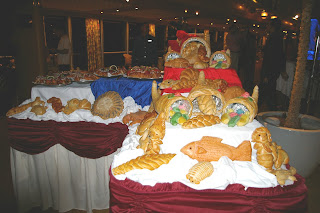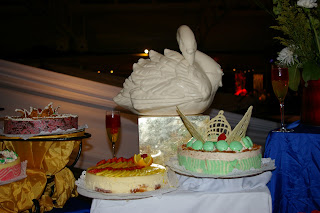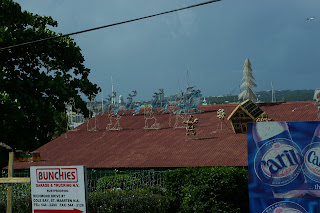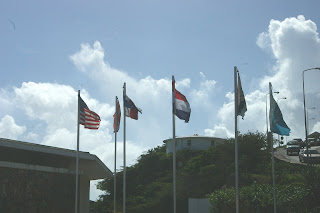My Choices were fruit dipped in white chocolate
a small eclair, and some other smaller chocolates.

A Chocolate Castle

A white chocolate Lion.

What an artistic way to display bread!

What a Spread!

A Chocolate Mermaid

An exotic display!

Colorfully displayed treats!

More goodies!

Even this swan is made from chocolate!

Yummy, yummy, yummy!

Amazing, what can be done to food for presentation!

Wines

Chefs

Captain and Officers

Our excellent waiter Dede.

Special Noordam Cake

This is the drawing where the
card actually rose up...how?
I haven't a clue.

These tourists are crazy being out in the
water in this cold and windy weather!

Nativity Scene
 Burger King
Burger King
As you can tell by the palm tree swaying
hard it was a very windy day!

Our ship was docked within walking distance of Old San Juan.
You can see the tip of the ship next to us, Carnival's Destiny.

Starbucks in Old San Juan.

View of Old San Juan Square.

Karen enjoying a break next to the Central Park Nativity Scene.

Sidewalk venders were pleased to serve us up cups of cold sherbert.

Alan standing by an unusual old tree in a park in Old San Juan.

Park in Old San Juan overlooking majestic buildings.

Staute of Christopher Columbus in Old San Juan

Karen enjoying the Nativity Scene at Old San Juan

Alan standing by Christmas tree in Old San Juan Center

Karen at park center of Old San Juan

Looking over the fort wall towards the sea.

Colorful housing in the city.

Dogs at play.

Fort-old next to the new.

Flags Flying Over Fort

Picture of Devil Tower

Fort Poster

Drawing of Fort

Low-income housing overlooing the ocean.

Alan getting onto our tour bus.
 Alan at the entrance to the Fort wall tunnel.
Alan at the entrance to the Fort wall tunnel.
Fort and Capitol Building

Fort San Juan

Day 9
Day 9 on our cruise was going to have a few showers but at 79’ who cared? We docked in Jan Juan, Puerto Rio at 7am so we ordered room service for breakfast so we’d be ready to disembark by 8:30. We had ordered eggs over easy, a ham and cheese omelet, grapefruit half, orange juice, bacon, sausage, English muffin, coffee and milk. The food was cold and there wasn’t even any butter for the muffin. We were really disappointed. I ended up eating the grapefruit and a banana that our cabin steward kept in our cabin for us. We figured we could just get something to eat on the island later.
From the Navigator: After departing Philipsburg we set a westerly course departed the Caribbean via Virgin Passage, which is the stretch of water between the islands of St. Thomas and Isla de Culebra. This passage led us to the Atlantic side of Puerto Rico, where San Juan is situated. Puerto Rico is Spanish for ‘rich port’. The name was first applied to its capital, known as San Juan Bautista de Puerto Rico, in the 16th century.
US Customs and Border Protection required that all guests attend US Immigration Inspection upon the arrival to San Juan, even if guests were not going ashore. Immigration Inspection began after the officials had boarded around 7am. Non-US citizens, including alien registration card holders had to go to the Hudson Room on Promenade Deck 3. US citizens went to the Queen’s Lounge on Lower Promenade Deck 2. Guests were called over the PA system by the deck on which their cabin was located. All guests were to bring their completed white immigration inspection card and passport or proof of citizenship plus photo ID with them. When leaving the ship everyone would have to show their blue clearance card and Holland America Line Guest ID Card in their hand as they approached the gangway for scanning at the security gate. We were all advised once we had disembarked we could not reboard the vessel until immigration procedures had been completed. This process went quite smooth, a lot better than the previous time. We were in and out in no time.
It was during the second voyage to the New World in 1493 that Columbus sighted the island of San Juan, later renamed Puerto Rico. With 272 miles of Atlantic and Caribbean coastline, and a culture dating back to the Taino Indians 2,000 years ago, Puerto Rico is a formidable attraction. The city roughly breaks down into several divisions, including the old walled city on San Juan Island. Old San Juan, the original city founded in 1521 contains authentic and carefully preserved examples of 16th and 17th century Spanish colonial architecture, some of the best in the New World. More than 400 buildings have been beautifully restored. Graceful wrought-iron balconies, decorated with lush green hanging plants, extend over narrow streets paved with blue-grey stones (ad equines, originally used as ballast for Spanish ships).
Background: What is known about Puerto Rico prior to European discovery is based on speculation and archaeology—there are no written records from the pre-Columbian period. Christopher Columbus discovered Puerto Rico in 1493 during his second voyage. The Taino people, a group of Arawaks who had reached Cuba, Hispanola, and Puerto Rico, greeted his party and offered a gift of gold ore. The mineral was abundant in the riverbed and while the nuggets were considered attractive ornaments, there was no association of monetary value—at least in the Western sense. Columbus was delighted. He informed his Spanish benefactors of the riches and named the bay Puerto Rico (port of the riches). The island name honored Saint John (later, the names were swapped). Columbus made two more journeys, but he never saw San Juan again.
The island owes its prosperity to Juan Ponce de Leon, one of Columbus’ lieutenants who returned in 1508 and claimed the island. He declared himself governor and established the city of Caparra, (La Ciudad Amurallada) by the year 1521.
During the era, regional events were dominated by the introduction of legalized slave trade and continual struggles with native peoples who realized their homeland was being usurped. Resulting intermittent skirmishes, and perhaps of equal importance, attacks by non-Spanish explorers, prompted the settlers to fortify the city. In 1521, construction began on thick walls and various fortresses to protect San Juan Harbor. By 1800, the city had been attacked and burned on many occasions, but no one had managed to wrest the territory from Spain. Great sugar plantations were producing the island’s wealth. The gold deposits had run out.
During the 19th century, things began to change in the Caribbean as nations abolished slavery. Political parties were formed in Puerto Rico for the first time, and by the end of the century, independence was granted, but autonomy came just in time for American troops to land on the island. San Juan Island was renamed ‘Porto Rico’ and the city was called San Juan.
What’s Ashore-Old San Juan. The 265-year old neighborhood was established as a military fort, but the 7-block area has evolved into one of the most charming city districts. The streets are paved with adoquine stones (note the distinct blue tint from their prior use as furnace slag) that arrived as ballast in Spanish ships. The streets of old town are narrow and steep—and traffic moves at a pretty fast clip.
There are four plazas in the old city, Plaza de San Jose, with its central statue of Ponce de Leon (fashioned from an 18th century British cannon), is a favorite meeting place. Next to the square is Plaza del Quincentenial, site of the 500th anniversary celebration of Columbus’ discovery of the Americas in October 1992. The statues in Plaza de Armas represent the four seasons, and Plaza de Colon was renamed on the 400th anniversary of Columbus’ second voyage.
The City Wall dates from the 1630s. Spanish built, it follows the shore, providing picturesque vantage points over the old city and the sea. The old city is a masterpiece in antique architecture, Alcaldia (City Hall), for example, was built between 1604 and 1789, but even some of the cafes were once colonial homes.
El Morro Fort-Even the full name of the fort—Fuerte San Felipe del Morro—is as imposing as the ramparts. The six-level citadel rises 140 feet above the sea, and its 18-foot wall would still be quite an obstacle—even for a modern assault. It fell only once, in 1538, when the Earl of Cumberland led his forces over the walls, but even after they gained entry, they were mired within an intricate complex of tunnels, dungeons, and ramparts. Construction took more than 200 years. A small museum explains the history.
San Jose Church-The second oldest cathedral in the Western Hemispher, Iglesia de San Jose was built in 1532, and remains as one of the city’s most beautiful. Ponce de Leon’s remains were in the crypt until they were moved to gothic San Juan Cathedral (adjacent to the Museum of Art and History on Plaza de San Jose) in 1913.
Port Particulars
The name Puerto Rico, was not reinstated until the 1930s. The Foraker Law, establishing civil government and free commerce between Puerto Rico and the US was approved and residents of the island were granted US citizenship in 1917. In recent years, the subject of renewing commonwealth status has been debated, but in 1993, voters reaffirmed their desire to remain as a territory, but only by a very narrow margin.
Beaches: Condado, Miramar, Ocean Park and Isla Verde. The area features deluxe hotels, restaurants, casinos and chick boutiques.
Historic Footprints
700 Ingeri and pre-Taino plazas are built
1000 Carib people in the Caribbean
1493 Christopher Columbus lands at Puerto Rico during his second voyage to the Americas. Ponce de Leon is a crewmember.
1506 Columbus dies at Valladolid, Spain
1508 Spain appoints Ponce de Leon to colonize Puerto Rico. Spanish ships under his command capture Taino people.
1511 Disputes between Taino and Spaniard lead to guerilla war. Ponce de Leon orders mass execution. Survivors flee. Diego Columbus, previously denied his father’s legacy, replaces de Leon.
1519 Government moves to San Juan. Puerto Rico is headquarters for the American-side Inquisition
1522 San Jose Church, oldest operating church in the Americas, is founded
1539 Spaniards begin fortifying San Juan. San Felipe del Morro Castle is begun
1542 Coconut trees (indigenous to Southeast Asia) introduced
1595 Sir Frances Drake attacks San Juan, but fails to capture it
1786 First history of Puerto Rico (Historia Geografica, Civil y Politica de Puerto Rico) published by Inigo Abbad y Lasierra
1820 Slavery abolished in Spain (but continues in Puerto Rico until 1873)
We docked in San Juan and took a city tour of both new and old San Juan and then up to the fort. The fort was humungous so I couldn't walk it but got some terrific shots from the ship plus I was able to take pictures of the posters on the walls of the entrance of the fort...and they turned out pretty good. I bought a package of 8-Pieces, which was how money was used. They would have a coin and then have it split into 8 pieces for different denominations, thus the phrase 2 bits, 4 bits, 6 bits a dollar. So now you learned your lesson for the day. I wanted to get an ornament in San Juan so we had the driver drop us off in Old San Juan, which was only a couple of short blocks from our ship. I found an open shop and got a couple of interesting ornaments, one a small cowbell and another was a wooden giraffe. Alan got me a colorful bracelet to go with all the dresses I'd gotten in St. Maarten. We walked through the town circle where it was all decorated with a nativity scene and Christmas decorations. We got ourselves some ice sorbet from a street vender and had a nice time there. We noticed a Starbucks on our walk through Old San Juan and would’ve stopped in for a frapaccino if we hadn’t already gotten a frozen treat earlier. There were plenty of benches for me to sit and rest along our walk in Old San Juan and to our ship.
Activities on the ship for the day included: the morning stretch, Fit Ball Core Training, mass, Interdenominational service, fresh hand shaken margarita sail-away party, volleyball, Spa Secrets talk on the ancient art of reflexology, Cure 5k walk, Pictionary Game, Spa Secrets talk on weight loss made easy, Sunday afternoon football on TV (Detroit Lions vs. Dallas Cowboys) and (New England Patriots vs Pittsburg Steelers), techsport with PowerPoint tips, watch event, Card players meet, ping-pong, art auction, Blackjack Tournament, Red Hat Ladies meeting, tennis serve Challenge, Songs and Songwriters with Justin Miller (this was a special performance as he presented wonderful stories of great Broadway and Hollywood songwriters including Irving Berlin, Rodgers & Hart, Cole Porter and more), afternoon tea, craft class making watch zipper pullers, yoga fitness, Team Trivia, BINGO, Hanukkah, and the Noordam Superstar Singing Competition.
For dinner I had Caesar salad, chilled apricot soup, peppered steak with veggies and potato and finishing it off with apple strudel for dessert.
The Show for the evening was with John D Smitherman, one of the most diverse singers ever heard, the Mario Lanza of this century. He has performed literally around the world. His resume consists of over 100 different roles on both the opera and musical theater stages. The show included songs made famous by Perry Como, Mario Lanza, Tom Jones, Frank Sinatra, and Pavarotti with some music from Showboat, Turandot and Phantom of the Opera.
One thing that seasoned cruisers always look forward to is the Chocolate Extravaganza that the cruise puts on. This one was a Dutch Chocolate Extravaganza, which included: a chocolate fountain, a chocolate martini, and of course chocolate cakes and goodies! Then there are all the carved images all done in chocolate along with beautiful ice sculptures. That night we were presented a high calorie photo opportunity. Their chefs had been busy creating a delectable concoction of chocolate desserts along with some classic favorites. There was a Miss Holland America Line’s Signature Espresso Martini for $5.25 offered for that night only. The buffet opened, for photo shoots only, at 10pm and service began at 10:30 up on the Lido Deck by the pool. The Four Seasons played for our enjoyment throughout the festivity. I took pictures of everything there was since I probably wouldn’t be eating much of it. The place was crowded and the only way we found a seat was to go inside the Lido buffet area. Alan went and chose a few samples for us while I waited for him. We also got a slice of pizza that was very good. Now, this was a great way to end our day!























 Parle Vous Francaise?
Parle Vous Francaise?




